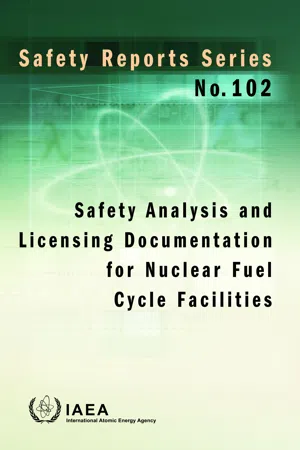1. INTRODUCTION
1.1. Background
IAEA Safety Standards Series No. SSR-4, Safety of Nuclear Fuel Cycle Facilities [1], establishes requirements for the demonstration of facility safety based on the safety analysis process as established in IAEA Safety Standards Series No. GSR Part 4 (Rev. 1), Safety Assessment for Facilities and Activities [2], and the preparation of documents known as the licensing documentation (or safety case). This Safety Report elaborates on the safety analysis process established by Requirements 1, 14–16 and 19–22 of SSR-4 [1].
Safety analysis is an analytical study, undertaken to demonstrate that the facility design meets safety and regulatory requirements and that the design is based on the application of sound engineering practices, research and feedback from operating experience (para. 6.10 of SSR-4 [1]). Systematic and recognized methods of deterministic analysis are required to be used for nuclear fuel cycle facilities, complemented by probabilistic assessments where appropriate, in accordance with a graded approach [1].
The entire range of conditions for which a nuclear fuel cycle facility is designed, according to established design criteria, forms its design basis. Within the design basis, a range of conditions and events caused by credible technical failures, operator errors or human induced or natural events, whose potential consequences may be significant in terms of facility safety or environmental protection, are explicitly taken into account according to established criteria. The safety analysis process, therefore, includes the identification of accident conditions, determination of the facility’s response to a range of postulated initiating events (PIEs) covering all facility states and the potential combination of PIEs, evaluation of event consequences and judgement of the acceptability of the results against the pre-established acceptance criteria.
The conditions caused by these events may be classified as anticipated operational occurrences (AOOs), design basis accidents (DBAs) or design extension conditions (DECs) on the basis of engineering judgement and the results of deterministic and probabilistic safety analyses. The DECs are accident conditions that are not considered for DBAs, but are considered in the design process of the facility, and for which releases of radioactive material are kept within acceptable limits. The DECs are used to identify the additional accident scenarios to be addressed in the design and to plan practicable provisions for the prevention of such accidents or mitigation of their radiological or associated non-radiological consequences. Analysis of DBAs and DECs is also used to establish plans for emergency preparedness and response for the facility.
The safety analysis process for nuclear fuel cycle facilities is based on the same general principles as for other types of nuclear facility, as specified in IAEA Safety Standards Series No. SSG-2, Deterministic Safety Analysis for Nuclear Power Plants [3], IAEA Safety Standards Series No. SSG-20, Safety Assessment for Research Reactors and Preparation of the Safety Analysis Report [4] and Safety Reports Series No. 55, Safety Analysis for Research Reactors [5]; however, its implementation at a specific facility could differ in several characteristics.
In accordance with Requirement 1 of SSR-4 [1], the safety of a nuclear fuel cycle facility has to be demonstrated through a set of documents known as the licensing documentation (or safety case), and this documentation has to include an adequate safety analysis report and the operational limits and conditions, as well as any other information required by the regulatory body. The licensing documentation provides the basis for the safety of the facility throughout its lifetime, and needs to be updated periodically to account for, among other things, modifications made to the facility and operating experience feedback. The IAEA Safety Standards covering the format and content of the safety analysis report for other types of nuclear facility are SSG-20 [4] and IAEA Safety Standards Series No. SSG-61, Format and Content of the Safety Analysis Report for Nuclear Power Plants [6]. However, different national regulatory requirements exist regarding the content of licensing documentation for nuclear fuel cycle facilities. Most of these national requirements define, in line with Requirement 1 of SSR-4 [1], the safety analysis report and the operational limits and conditions as key components of the documentation.
This publication addresses the features of safety analysis and licensing documentation specific to nuclear fuel cycle facilities, and has to be used in conjunction with the appropriate IAEA Safety Standards for nuclear fuel cycle facilities [1, 2, 7–12].
1.2. Objective
The objective of this publication is to provide information on methods and practices, based on the IAEA safety standards and current international good practice, for performing safety analysis and preparing licensing documentation for nuclear fuel cycle facilities.
The approaches provided in this publication can be applied to different types of nuclear fuel cycle facility with use of a graded approach that is commensurate with the potential hazards and risks posed by the facility. The design and operational features of a specific nuclear fuel cycle facility also need to be considered as described in this publication.
The information in this publication is of practical use to the operating organizations, regulatory bodies and other organizations involved in the safety of nuclear fuel cycle facilities, inclu...
